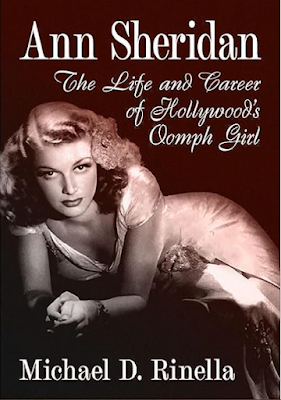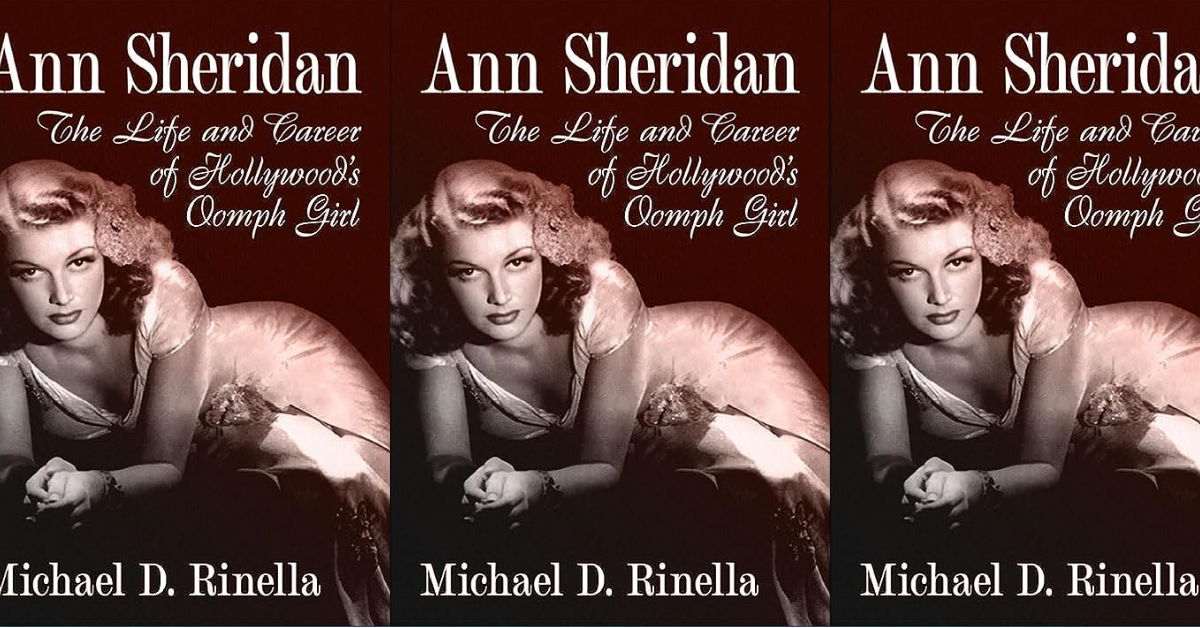It’s remarkable that Ann Sheridan, an icon from Hollywood’s golden age, is receiving her first biography 57 years after her passing in 1967. Sheridan is fortunate to have Michael D. Rinella as her biographer, who offers a detailed, compassionate, and truthful portrayal of the actress. Rinella’s book, Ann Sheridan: The Life and Career of Hollywood’s Oomph Girl, is now available.
 |
| Ann Sheridan during her time at Warner Brothers. |
Many sex symbols from the 1940s, such as Grable, Turner, and Hayworth, have had their own biographies. However, while Ann Sheridan was a beloved star of her time, her career dwindled after she departed Warner Brothers. Although her personal life was vibrant, it wasn’t as storied as those of Crawford, Turner, or Hayworth. A significant reason for her waning public recognition was her untimely death at the age of 51 in 1967. Biographer Rinella addresses this oversight with a captivating narrative about Clara Lou Sheridan’s journey from Texas to Hollywood stardom at Warner Brothers.
 |
| Ann Sheridan in a prominent role in the 1938 film “Angels with Dirty Faces,” alongside James Cagney and Pat O’Brien. |
Thanks to the lasting appeal of classic cinema and the influence of TCM, Ann Sheridan has begun to receive recognition as a versatile and charismatic artist. She excelled in comedy, showcased her talent as a dramatic actress, and even displayed her singing ability. Notably a natural redhead, Sheridan bore a resemblance to her contemporaries Rita Hayworth and Lucille Ball. Her undeniable charm led Warner Brothers to refer to her as “The Oomph Girl.”
 |
| Ann Sheridan combined glamour with a playful sense of humor. |
A highlight of Rinella’s biography is his use of numerous quotes from Ann’s own interviews. Fortunately for Rinella, Sheridan was straightforward in her remarks, making her reflections accessible and relatable. She possessed a self-awareness and a humorous nature reminiscent of the late Carole Lombard.
 |
| Ann Sheridan found a significant lead role in 1940’s “It All Came True.” |
Some stars make their mark instantly, like Greer Garson, Katharine Hepburn, or Lauren Bacall. Others face a more daunting climb to success, as seen with Marilyn Monroe, Betty Grable, and Ann Sheridan. Success doesn’t solely rely on talent; it often hinges on studio backing or sheer luck. Having supportive producers or directors can be crucial. For some starlets, interest from the public didn’t guarantee their success, as industry executives often overlooked them. L.B. Mayer, for instance, favored established icons like Garbo and Shearer rather than more flamboyant talents like Jean Harlow, to whom Sheridan was later compared. Monroe, Grable, and Sheridan all faced prolonged periods as struggling starlets before achieving significant success at different studios.
Once stars like Betty Grable gained recognition at 20th Century Fox, they were treated like true stars. However, both Monroe and Sheridan dealt with underpayment despite their popularity—Monroe’s situation at Fox and Sheridan’s between Paramount and Warner Brothers. Both actresses legally contested their respective studio heads, Darryl Zanuck and Jack Warner. Unlike Monroe, who faced a more challenging dynamic at Fox, Sheridan was pragmatic, confident, and well-regarded by her peers.
 |
| Ann Sheridan took center stage alongside Cagney & O’Brien in 1940’s “Torrid Zone.” |
Rinella effectively provides context about the important figures in Sheridan’s life, providing clarity on her career decisions. While he’s a devoted fan of Sheridan, he also offers an honest assessment of her personal and professional challenges that impacted her career.
 |
| In “The Man Who Came to Dinner,” it was Ann Sheridan as vain star Lorraine Sheldon who truly stole the spotlight! |
Like many of her contemporaries, Ann desired to showcase her talents while navigating the typical pitfalls of the era. She declined the role in The Strawberry Blonde, despite it being the title character, because it was a supporting role that ultimately helped Rita Hayworth rise to fame. Ann, amongst others, also passed on Mildred Pierce, rightly so given her age of 30 at the time, and turned down To Have and Have Not even though she adored Bogart, maybe due to the similarity to her role in Torrid Zone. Warner Brothers even wanted her for a role in Caged, but Sheridan likely envisioned herself in a role that ended up going to Agnes Moorehead. Nevertheless, she hesitated to embrace character roles, leading to co-star Betty Field, who somewhat resembled a more melancholic Sheridan, snagging pivotal parts in hits like Picnic, Bus Stop, Peyton Place, and BUtterfield 8. While Ann maintained her leading lady status with pride, one must wonder what good is being a star without the opportunity to shine.
Her personal lifestyle choices—like nightlife, drinking, and chain-smoking—took a toll on her appearance, a common plight among both genders in the golden age of cinema. The top stars continued to attract audiences, receiving additional care for their makeup, hair, and lighting, including iconic names such as Lana Turner, Joan Crawford, and Lucille Ball, compared to less showy actresses like Sheridan and Joan Blondell who struggled to remain relevant.
Despite this, Sheridan actively sought to reshape her career after leaving the studio system, exploring independent films, television, and theatre opportunities. The 1950s and 60s were particularly tough for aging stars, especially women, as roles became scarce.
Rinella provides an in-depth analysis of Ann’s tumultuous journey to film stardom and her often unfulfilled quest for love. I found Ann’s choice of George Brent as a husband surprising, given her vivacious spirit contrasted with his more subdued presence on screen. Brent was reportedly moody and antisocial, further perpetuating the mystery behind their union. When I inquired about the absence of children in Sheridan’s life, Rinella, despite being thorough in his research, could not pinpoint an answer. This aspect likely influenced her overall outlook on life.
Rinella’s portrayal of Sheridan’s final years is particularly poignant, highlighting her later work in television and on stage amid varying degrees of success. Ann underwent some cosmetic procedures that enhanced her appearances, such as in the CBS sitcom Pistols ‘n’ Petticoats. Sadly, it was during this period that Sheridan was diagnosed with throat cancer. Following a rapid decline, she passed away on January 21, 1967, just a month shy of her 52nd birthday, albeit having found happiness with her final husband, actor Scott McKay.
 |
| Ann Sheridan’s final role was in CBS’s sitcom “Pistols ‘n’ Petticoats,” where her health issues were already evident. |
Although Ann’s talents are being reassessed today, the recognition has not been as swift as that of other actors who have enjoyed a revival. Ann Sheridan had a unique ability to blend comedy and drama, reminiscent of Carole Lombard. Additionally, her brash persona evoked the same kind of energy found in Harlow, while her sharp wit was comparable to that of Eve Arden.
 |
| Ann Sheridan starred alongside Bogart & George Raft in the 1940 film “They Drive By Night.” Despite Ida Lupino’s standout performance, Ann held her own as a kind-hearted waitress. |
For those interested in exploring more of Ann Sheridan’s work, notable films include the urban melodramas Angels with Dirty Faces, City of Conquest, and They Drive by Night. In Kings Row, she outshines her younger co-stars with her warm portrayal of Randy Monaghan. Additionally, her performances in romantic noirs like Nora Prentiss, The Unfaithful, and Woman on the Run demonstrate her skill. She also shone in comedies such as It All Came True, Torrid Zone, The Man Who Came to Dinner, The Doughgirls, George Washington Slept Here, and I Was a Male War Bride—a commendable legacy for an actress who often went underappreciated.
 |
| Ann Sheridan & Cary Grant shared delightful on-screen chemistry in Howard Hawks’ 1948 screwball comedy, “I Was a Male War Bride.” Ann could have thrived with more collaborations with Hawks! |
Cher once remarked on her own acting range, claiming she excelled at portraying “tarts with a heart.” This description is equally applicable to Ann Sheridan, who was unforgettable as working-class women with kindness and integrity. Sheridan possessed the “oomph” she often resented, along with a genuine authenticity as an actress.
.jpg) |
| Ann Sheridan portrayed many such characters during her peak in Hollywood! |
Michael D. Rinella successfully brings Ann Sheridan back into the spotlight with a well-researched, engaging, and honest biography that chronicles her life and career.
 |
| Follow the link below for more information or to purchase this new biography of Ann Sheridan. |
Here’s the Amazon link to Ann Sheridan: The Life and Career of Hollywood’s Oomph Girl:
https://www.amazon.com/Ann-Sheridan-Career-Hollywoods-Oomph/dp/1476694184
 |
| Ann Sheridan as “Nora Prentiss,” the most charming femme fatale of film noir! |
For a deeper dive into Ann Sheridan’s film noir phase in Nora Prentiss, check out my article here:
https://ricksrealreel.blogspot.com/2019/02/ann-sheridans-glamour-brightens-gloomy.html
 |
| Ann Sheridan shines in her standout role as Randy in the classic film “Kings Row.” |
For my insights on Ann’s best film role in Kings Row, click here:
https://ricksrealreel.blogspot.com/2017/01/kings-row-is-much-more-than-reagans.html





